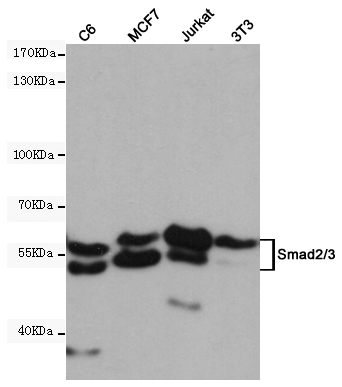SMAD2 Mouse Polyclonal Antibody
Other products for "SMAD3"
Specifications
| Product Data | |
| Applications | IHC, WB |
| Recommended Dilution | WB: 1/1000 |
| Reactivities | Human, Mouse, Rat |
| Host | Mouse |
| Isotype | IgG |
| Clonality | Polyclonal |
| Immunogen | Recombinant Protein of Smad3 |
| Formulation | Liquid in PBS containing 50% glycerol, 0.5% BSA and 0.03% Proclin 300, pH 7.3. |
| Concentration | lot specific |
| Purification | Affinity Purified |
| Conjugation | Unconjugated |
| Storage | Store at 4°C short term. Aliquot and store at -20°C long term. Avoid freeze/thaw cycles. |
| Stability | 1 year |
| Predicted Protein Size | Observed MW(kDa):52/60 |
| Gene Name | SMAD family member 2 |
| Database Link | |
| Background | Swiss-Prot Acc.P84022.Members of the Smad family of signal transduction molecules are components of a critical intracellular pathway that transmit TGF-β signals from the cell surface into the nucleus. Three distinct classes of Smads have been defined: the receptor-regulated Smads (R-Smads), which include Smad1, 2, 3, 5, and 8; the common-mediator Smad (co-Smad), Smad4; and the antagonistic or inhibitory Smads (I-Smads), Smad6 and 7 . Activated type I receptors associate with specific R-Smads and phosphorylate them on a conserved carboxy terminal SSXS motif. The phosphorylated R-Smad dissociates from the receptor and forms a heteromeric complex with the co-Smad (Smad4), allowing translocation of the complex to the nucleus. Once in the nucleus, Smads can target a variety of DNA binding proteins to regulate transcriptional responses . |
| Synonyms | hMAD-2; hSMAD2; JV18; JV18-1; MADH2; MADR2; MGC22139; MGC34440 |
| Reference Data | |
Documents
| Product Manuals |
| FAQs |
| SDS |
{0} Product Review(s)
0 Product Review(s)
Submit review
Be the first one to submit a review
Product Citations
*Delivery time may vary from web posted schedule. Occasional delays may occur due to unforeseen
complexities in the preparation of your product. International customers may expect an additional 1-2 weeks
in shipping.






























































































































































































































































 Germany
Germany
 Japan
Japan
 United Kingdom
United Kingdom
 China
China





